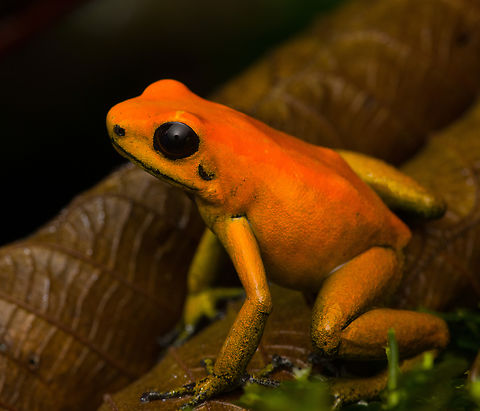
Appearance
Under the genus "Phyllobates", this organism is often mistaken as "Phyllobates terribilis", the golden poison frog, as both are morphologically similar. However, "Phyllobates" "bicolor" is identifiable by the yellow or orange body and black or dark blue forelimbs and hindlegs, hence the name black-legged dart frog. "Phyllobates bicolor" are commonly found in tropical forests of the Chocó region of Colombia. The diurnal frogs live along the rainforest ground near streams or puddles that form. Notably, "P. bicolor" is a member of the family "Dendrobatidae", or poison dart frog.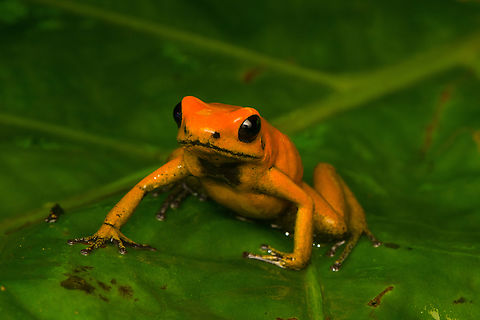
Distribution
"Phyllobates" frogs follow an interesting pattern of phenotypic distribution. Across the western South American coast, the frogs exhibit a leapfrog distribution pattern. A leapfrog pattern describes a set of phenotypically similar populations that have been separated by at least one phenotypically unrelated population. "P. bicolor", only one of the five species of frog found between Nicaragua and Colombia, are geographically isolated from other species of frog with the exception of "P. terribilis."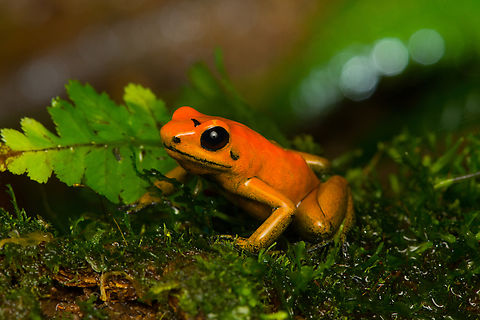
Status
"P. bicolor" currently faces a major threat of habitat loss. Significant drivers of habitat loss include deforestation, cattle grazing, mining, pollution, and illegal crop spraying. Deforestation of the rain forest most directly impacts "P. bicolor" as the process contributes to exposing the frogs that live along the floor of the forest. The removal of trees makes the rainforest floor dry, hot, and without available food for the frogs. Additionally, cattle grazing and unsustainable farming practices cause harm to the land. Again, these processes stress the environment and cause potential harm to the frogs. Mining, pollution, and illegal crop spraying influence the environment as well. Strip mining destroys the landscape, trees, plants, and soil of the rainforest. The loosened topsoil is unfit to host any life, which further harms the frogs as there is no natural cover along these areas to protect the frogs or to lay eggs. Pollution causes death of the frogs as pollutants from industrialization and urbanization of the rainforest are toxic to the frogs.Invasive species such as "Batrachochytrium dendrobatidis," or "Bd", endanger the frogs, too. "Bd" causes the disease chytridiomycosis, a very lethal amphibian skin disease found in many parts of the world, including South America. "Bd" is an invasive aquatic fungi that causes the skin infections on frogs. The fungi can live in soil or water. When in aquatic environments, "Bd" spores are motile. The presence of terrestrial and aquatic forms of the fungi present a great threat to "P. bicolor". "Bd" infects the keratinized skin of amphibians and slowly hardens these areas. Since the skin is physiologically active in maintaining a regulated electrolyte balance, respiratory gas exchange, and osmotic imbalance, "Bd" prevents these vital functions and eventually kills the organism.
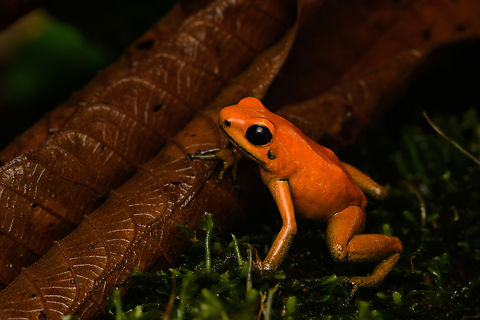
Reproduction
During the wet season around September and October, "P. bicolor" begins to reproduce. Typically, a male will call to any nearby females by trilling or buzzing, creating a series of pulsating and repeating high-pitched notes. If two male calls are emitted, the two males will compete with one another until one emerges victorious and the loser must leave the area in search for another female. Oftentimes, the male will selected a suitable location for female oviposition prior to the mate actually depositing her eggs. These locations are typically damp areas such as leaf litter, on certain plants, or under rocks. Common to most species of frogs, "P. bicolor" fertilizes eggs externally. For this to occur, the male wraps around the female and releases his sperm as the female begins depositing her eggs. The eggs remain protected by one of the parents until they become ready to hatch. This behavior of parental care is common among other species of poison dart frog. At this stage, the male hoists the tadpoles onto his back and begins searching for a location with water to complete the development of the tadpoles. In addition to moving the tadpoles to water, the toxins on the father's back rub off onto the tadpoles, so if a predator were to eat one of the offspring, the predator would get poisoned and the rest of the frogs would be protected. After three weeks in the aquatic environment, the offspring are ready to leave and become terrestrial. During this period, the male fiercely defends his territory and tadpoles from foreign males.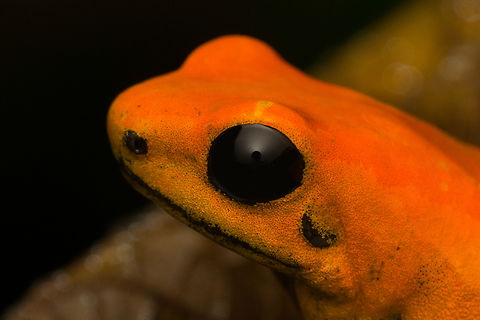
Defense
"P. bicolor," along with the rest of the "Phyllobates" species, produce a neurotoxin known as a batrachotoxin that inhibits specific transmembrane channels in cells. Due to this highly deadly toxin that the frogs secrete, many indigenous groups of the Colombian rainforest have extracted the toxins to create poison tipped darts used for hunting. During the breeding period, "P. bicolor" emits high pitched single notes as a mating call. As in all poison dart frogs, it is common for the father of tadpoles to carry the offspring on his back until they reach a suitable location for the tadpoles to develop. "P. bicolor" is an endangered species according to the IUCN red list. Currently, deforestation, habitat loss, and pollution pose the biggest threat to the species. Limited conservation efforts have been attempted to prevent further damage to the species. Despite this, there are still institutions such as the Baltimore National Aquarium in Baltimore, Maryland and the Tatamá National Park in Colombia that are engaged in "P. bicolor" conservation efforts such as captive breeding.References:
Some text fragments are auto parsed from Wikipedia.